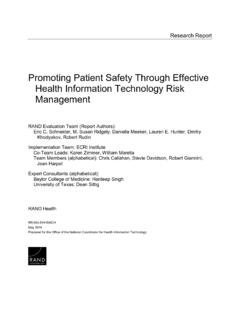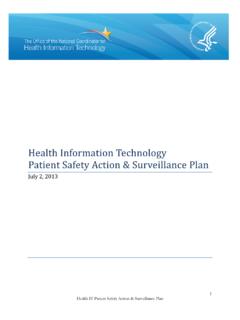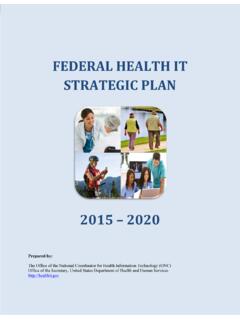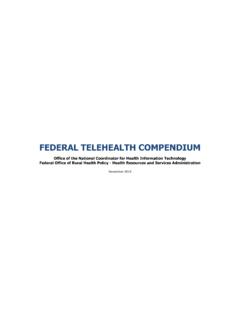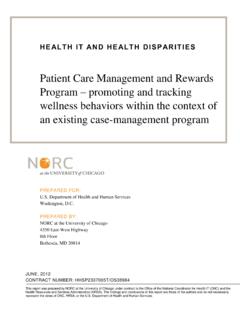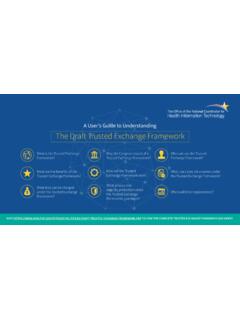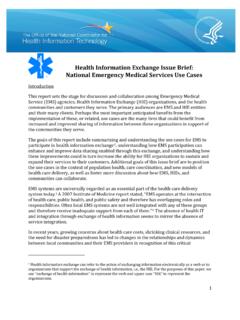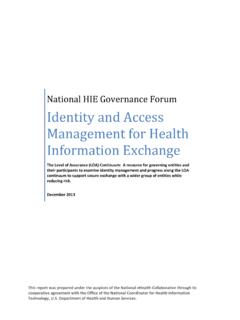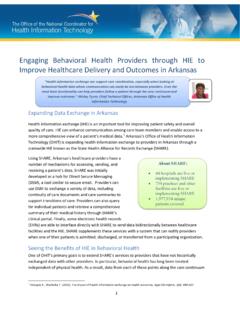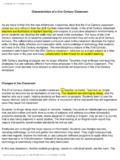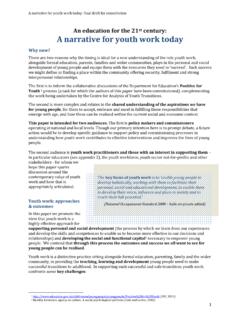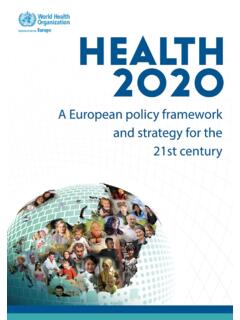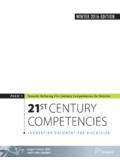Transcription of 21st Century Cures Act Overview for States - ONC
1 21st Century Cures Act Overview for States SIM State Educational Session 1. An Overview of the 21st Century Cures Act for States Genevieve Morris, Principal Deputy National Coordinator for Health IT, ONC. Elise Sweeny Anthony, JD, Director, Office of Policy, ONC. January 8, 2018. Goals for These Learning Sessions 1. What does the Cures Act say? Not seeking to interpret the Cures Act, but extracting important language associated with key topics of potential interest to States . Use this information to plan your own activities and understand how the Cures Act may have an impact on your projects. 2. Who is responsible for each action? The Cures Act usually identifies the party responsible for completing each of the actions it identifies, often in collaboration with others.
2 Use this information as a basis for who to monitor in order to keep abreast of progress, and how best to participate in public forums, if any. 3. When is each action due? The Cures Act usually identifies dates by which progress is due. Use this information in planning your own activities, and for a general sense of the timeline for Cures Act activities. An Overview of the 21st Century Cures Act for States 2. Goal for Today An Overview of What, Who, and When for each of the topic areas of Title IV of the Cures Act, which focuses on Delivery An introduction to the contents of the Cures Act of interest to States , identifying what it is to accomplish and ONC's role Future sessions will provide more detail on individual topics Key outcome Begin to think about how to apply outcomes of the Cures Act to your own initiatives For details of the 21st Century Cures Act, see Summary: Full Text: An Overview of the 21st Century Cures Act for States 3.
3 History of the 21st Century Cures Act 01/06/2015 Introduced in House 01/07/2015 Passed/agreed to in House 10/06/2015 Passed/agreed to in Senate: Passed Senate with an amendment 11/30/2016 House actions: House agreed with an amendment to the Agreed to 12/07/2016 Senate actions: Senate agreed to the House amendment to the Senate amendment 12/08/2016 Presented to President 12/13/2016 Signed by President and became Public Law An Overview of the 21st Century Cures Act for States 4. 21st Century Cures Act Title IV DELIVERY. Sec. 4001. Assisting doctors and hospitals in improving quality of care for patients. Sec. 4002. Transparent reporting on usability, security, and functionality. Sec. 4003. Interoperability.
4 Sec. 4004. Information blocking. Sec. 4005. Leveraging electronic health records to improve patient care. Sec. 4006. Empowering patients and improving patient access to their electronic health information. Sec. 4007. GAO study on patient matching. Sec. 4008. GAO study on patient access to health information. Sec. 4009. Improving Medicare local coverage determinations. Sec. 4010. Medicare pharmaceutical and technology ombudsman. Sec. 4011. Medicare site-of-service price transparency. Sec. 4012. Telehealth services in Medicare. An Overview of the 21st Century Cures Act for States 5. Section 4001. Assisting doctors and hospitals in improving quality of care for patients 4001(a) Amends the HITECH Act to require HHS to establish a goal, develop a strategy, and make recommendations to reduce regulatory or administrative burdens relating to the use of EHRs 4001(b) ONC must encourage, keep, or recognize the certification of health IT for use in medical specialties HHS must adopt certification criteria to support health IT for pediatrics, and begin certification soon after 4001(c) HHS must publish attestation statistics for the Medicare and Medicaid EHR.
5 Incentive Programs to Health Information Technology Advisory Committee An Overview of the 21st Century Cures Act for States 6. Section 4002. Transparent reporting on usability, security, and functionality 4002(a) Requires HHS through notice and comment rulemaking to require, as a condition of certification and maintenance of certification, that the HIT. developer or entity does not take any action that constitutes information blocking (as defined in Section 3022(a) of the Public Health Service Act, as amended), or any other action that may inhibit the appropriate exchange, access, and use of electronic health information . 4002(b) A health care provider whose adopted health IT is decertified is exempted from the application of a payment adjustment 4002(c) HHS must support the convening of stakeholders to develop reporting criteria An Overview of the 21st Century Cures Act for States 7.
6 Section 4003. Interoperability 4003(a) Defines Interoperability as: The term interoperability', with respect to health information technology, means such health information technology that . A. enables the secure exchange of electronic health information with, and use of electronic health information from, other health information technology without special effort on the part of the user;. B. allows for complete access, exchange, and use of all electronically accessible health information for authorized use under applicable State or Federal law; and C. does not constitute information blocking as defined in section 3022(a) of the PHSA as amended. An Overview of the 21st Century Cures Act for States 8.
7 Trusted Exchange Framework and Common Agreement 21st Century Cures Act - Section 4003(b). Not later than 6 months after the date of enactment of the 21st Century Cures Act, the National Coordinator shall convene appropriate public and private stakeholders to develop or support a trusted exchange framework for trust policies and practices and for a common agreement for exchange between health information networks. The common agreement may include . (I) a common method for authenticating trusted health information network participants;. (II) a common set of rules for trusted exchange;. (III) organizational and operational policies to enable the exchange of health information among networks, including minimum conditions for such exchange to occur; and (IV) a process for filing and adjudicating noncompliance with the terms of the common agreement.
8 21st Century Cures Act - Section 4003(c). Not later than 1 year after convening stakeholders the National Coordinator shall publish on its public Internet website, and in the Federal register, the trusted exchange framework and common agreement developed or supported under paragraph B . 9. Format of the Draft Trusted Exchange Framework Part A Principles for Trusted Exchange General principles that provide guardrails to engender trust between Health Information Networks (HINs). Six (6) categories: Principle 1 - Standardization: Adhere to industry and federally recognized standards, policies, best practices, and procedures. Principle 2 - Transparency: Conduct all exchange openly and transparently.
9 Principle 3 - Cooperation and Non-Discrimination: Collaborate with stakeholders across the continuum of care to exchange electronic health information, even when a stakeholder may be a business competitor. Principle 4 - Security and Patient Safety: Exchange electronic health information securely and in a manner Part B Minimum Required Terms and that promotes patient safety and ensures data integrity. Conditions for Trusted Exchange Principle 5 - Access: Ensure that patients and A minimum set of terms and conditions for the purpose of their caregivers have easy access to their electronic ensuring that common practices are in place and required health information. of all participants who participate in the Trusted Exchange Principle 6 - Data-driven Accountability: Exchange Framework, including: multiple records at one time to enable identification Common authentication processes of trusted health and trending of data to lower the cost of care and information network participants.
10 Improve the health of the population. A common set of rules for trusted exchange;. A minimum core set of organizational and operational policies to enable the exchange of electronic health information among networks. 10. Need for the Trusted Exchange Framework Complexity CURRENT PROLIFERATION. OF AGREEMENTS. Many organizations have to join multiple Health Information Networks (HINs), and the HINs do not share data with each other. Trusted exchange must be simplified in order to scale. Each line color on the map represents a different network. There are well over 100 networks in the 11. Need for the Trusted Exchange Framework Costs Costs to healthcare providers due to lack of Trusted Exchange Framework Healthcare organizations are currently burdened with creating many costly, point-to-point interfaces between organizations.
